Introduction
Every gardener deserves a comfortable, organized space to work, pot plants, and take in the beauty of their blooms. One of the most practical yet overlooked tools for creating that space is the gardening bench. Whether you’re an urban grower with a small patio or tending a sprawling backyard garden, the right bench makes planting, pruning, and repotting a breeze.
Beyond convenience, a well-designed bench can also enhance your garden’s charm — blending form and function seamlessly. In this guide, you’ll learn everything about selecting, building, and styling the ideal gardening bench to match your space and needs.
1. Why Every Gardener Needs a Gardening Bench
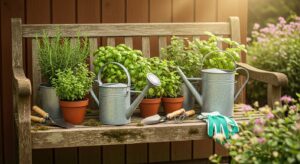
Working at ground level can strain your back and knees. A sturdy gardening bench raises your workspace to a comfortable height, allowing you to plant and pot without bending excessively.
It’s also perfect for:
-
Mixing soil or fertilizer
-
Storing garden tools neatly
-
Arranging seed trays and pots
-
Enjoying a cup of tea while admiring your handiwork
Bonus: A bench creates a central hub for your gardening routine — keeping everything within arm’s reach.
2. Choosing the Right Material for Your Gardening Bench
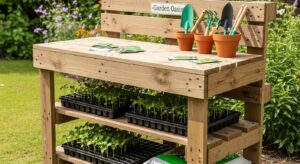
The material you choose affects durability, style, and maintenance.
Wood:
Classic and natural-looking, wood fits seamlessly into outdoor settings. Opt for cedar or teak, which resist moisture and rot.
Metal:
Aluminum or steel benches are sleek and durable. They handle wet conditions well but can heat up under direct sunlight.
Plastic or Resin:
Lightweight and budget-friendly, these options are perfect for beginners or small spaces.
Pro Tip: If your bench will stay outside year-round, apply a protective finish to prevent rust or wood decay.
3. Essential Features to Look for in a Gardening Bench
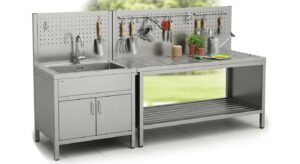
Before you buy or build one, make sure it includes features that enhance functionality:
-
Shelves or Drawers: Store small tools, seeds, and gloves.
-
Hooks: Hang hand tools or garden aprons.
-
Work Surface: Choose one that’s easy to clean — galvanized metal tops are ideal for messy potting.
-
Backboard or Pegboard: Perfect for organizing tools vertically.
-
Sink or Basin: Optional, but great for washing vegetables or cleaning soil off roots.
A well-equipped gardening bench keeps everything tidy and efficient — no more searching for misplaced shears!
4. DIY Gardening Bench Ideas for Creative Gardeners
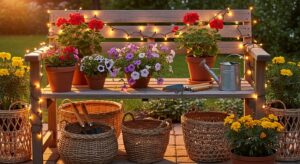
If you enjoy hands-on projects, building your own bench can be incredibly rewarding.
Simple DIY Design:
Use reclaimed wood or pallets to build a rustic, budget-friendly structure. Add shelves and a top work surface for potting tasks.
Upcycled Options:
Convert an old dresser or table into a bench by removing drawers and adding waterproof lining.
Folding Bench:
For tight spaces or balconies, make a foldable bench that can be stored when not in use.
DIY Tip: Finish your homemade bench with outdoor paint or a waterproof sealant to extend its life and match your garden’s theme.
5. Styling Your Gardening Bench
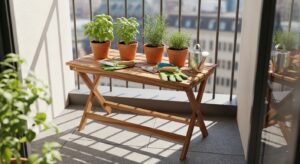
A gardening bench doesn’t have to be purely functional — it can also be a centerpiece.
Decorating ideas:
-
Hang small potted herbs or succulents above it.
-
Use baskets for tool storage instead of plastic bins.
-
Add fairy lights for a cozy evening glow.
-
Display garden décor like lanterns or birdhouses on the top shelf.
Aesthetic Touch: Coordinate your bench’s color with your garden’s flowers or patio furniture for a cohesive look.
6. Keeping Your Gardening Bench Organized

A clutter-free bench boosts productivity and peace of mind. Try these quick tips:
-
Label jars or boxes for seeds and bulbs.
-
Store heavy tools on the bottom shelf to prevent tipping.
-
Keep cleaning wipes or cloths handy for quick surface care.
-
Use magnetic strips to hold metal tools securely.
Routine Tip: Dedicate 10 minutes each week to tidying up — your future self will thank you during planting season!
7. Maintenance Tips to Extend the Life of Your Gardening Bench
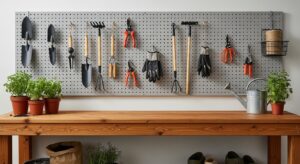
Like your plants, your bench needs care too.
-
Clean regularly: Wipe soil and debris after every use.
-
Seal annually: Apply wood oil or varnish for wooden benches.
-
Check for rust: For metal benches, sand and repaint rusty spots.
-
Cover during rain: Use a waterproof tarp or store it under a shed roof.
Consistent upkeep ensures your gardening bench stays beautiful and functional year after year.
8. The Perfect Spot for Your Gardening Bench

Placement matters! Choose a location that’s both practical and pleasant.
-
Near a water source for easy cleaning and watering.
-
Close to your garden beds for quick access.
-
In a shaded or semi-shaded area to protect you (and the bench) from harsh sun.
If you enjoy multitasking, place your bench where you can admire your blooms — it doubles as a relaxation nook!
9. Seasonal Uses Beyond Gardening
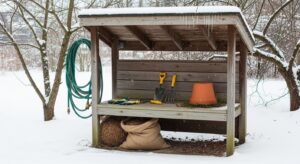
A gardening bench isn’t just for planting season. Here’s how to use it year-round:
-
Spring: Start seedlings and organize tools.
-
Summer: Display potted plants and herbs.
-
Autumn: Decorate with pumpkins and gourds.
-
Winter: Store garden supplies or use it as a hot cocoa station outdoors!
Your bench can evolve with every season — functional, festive, and full of charm.
10. Creating a Personal Touch

Add details that make your bench feel uniquely yours. Paint your name on it, hang a small chalkboard for garden notes, or include a quote like “To plant a garden is to believe in tomorrow.”
Small creative details transform your gardening bench from a tool into a cherished garden companion.
Conclusion
A gardening bench is more than just a workspace — it’s a cornerstone of a well-loved garden. Whether purchased, repurposed, or handcrafted, it adds structure, style, and efficiency to your outdoor haven. With thoughtful organization and regular care, your bench will support countless planting sessions and creative projects.
So roll up your sleeves, find the perfect spot, and let your gardening bench become the heart of your garden.